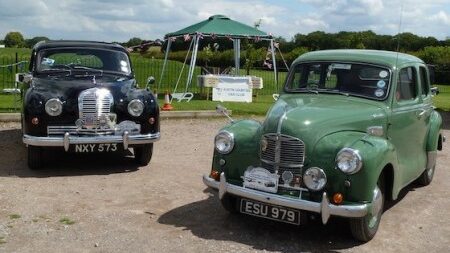My father taught me to drive in our family’s Austin A40 Devon, of 1951 vintage.
The A40 wasn’t, by Cornish standards, too old in 1962, the year in which I shed my L-plates, and was positively space-age compared with the Ford Model T van in which he had learned before being one of the first to take the driving test in 1935, the year of its introduction.
Even today I drive a 10-year-old X-Trail, but in Cornwall’s ailing economy (being geographically somewhat beyond the arse-end of beyond, its economy has always ailed), this isn’t considered particularly old.
It goes well, is paid for, I don’t give two hoots for the latest registration number, and with almost 99,000 miles on the clock it’ll be off to Skye and Mull again in a few months’ time. In any case, last year the Duchy was recognised as the EU’s poorest area – I’m awaiting a food parcel from Poland as I sit at my coal-fired laptop.
Anyhow, whine ye not, as Frankie Howerd might have said; let’s take a look at the A40 Devon. This four-door saloon, with drum brakes all round, was produced from 1947-’52, and even in ’62 was still considered to be rather smart.
Under the longish bonnet, proudly displaying the “Flying A” mascot, an efficient pedestrian-disemboweller, was a carburettor-fed 1.2-litre overhead valve, four-cylinder engine, started by pulling a dash-mounted switch. It was reckoned that this little engine could get the vehicle up to a staggering 72mph.
There were semaphore-arm indicators rather than flashers, a choke, and an extremely small, unheated rear window which seemed to be constantly steamed up, even when, as a youngster, I wasn’t parked up in some secluded spot with a young lady.
The centrally-split front bench seat could, at a push, accommodate three people, while the unbelievably long gear-stick came from somewhere in the darkness up front, making just enough space, either side of the transmission tunnel, for the central occupant’s carefully-placed feet. The hand brake, pulled out from under the dashboard, was another space saver.
Beneath the bonnet a dominating feature was an air cleaner resembling an enormous saucepan; the battery was positioned centrally back against the bulkhead, making it all but impossible, without the use of a mirror, to check the distilled water level in each cell.
When it came to equipment, the list of what it didn’t have because much had not yet been invented, was as long as that gear-stick
For example – seatbelts, central locking, air bags, power steering, hazard flashers, blinking indicators, electric windows, GPS, self-parking wipers, screen washers, fuel-injection and hand-operated dip-switch (it was a button on the floor, and extinguished the offside headlight when depressed). It did, however, have a starting handle, an essential bit of kit as there was a dynamo rather than an alternator.
On 20 September 1962, my ol’ Dad’s endless patience was rewarded when I passed my driving test in the A40. Later that day, armed with the knowledge that I was now a qualified driver and officially recognised as knowing it all, I set out by myself for the first time. This was more like it – it was a sensation I’ve never managed to re-capture!
With nobody to bring sanity to the proceedings I hared off down a favourite country road and rocketed up an embankment crowned by a humped bridge over the railway line. There, the fun ended.
The car took off, my head hit the roof, the vehicle slammed back on to the road and appeared to bounce once. That nothing broke was testimony to its ruggedness, while the fact that nothing was coming the other way and I managed to keep going in a reasonably straight line was a minor miracle.
Thus began a learning process and realisation of mortality, which continues to this day.
Group classic car expert Kim Henson has been doing his homework for us and added to Nigel’s knowledge.
The A40 Devon plus the two-door A40 Dorset, similar mechanically, was the first Austin to feature independent, coil and wishbone type front suspension, says Kim Henson.
The Counties range of Austins included: A40 Dorset two door saloon only and four door A40 Devon; A70 Hampshire, replaced by the A70 Hereford and A40 Somerset.
The rarer van, pick-up and Countryman estate models all featured Devon-style bodywork, and production continued with these until 1957, some five years after the Devon saloons had ben discontinued.
All the ‘Counties’ Austins featured a separate, very heavy-duty chassis.
The Somerset was replaced by the unitary construction A40 (1200cc)/A50 (1489cc) Cambridge of 1954.
The A40 Devon based A40 Sports convertible featured aluminium bodywork by Jensen, and an uprated, twin carburettor version of the A40’s 1200cc engine. This model is much sought-after today.
Images show an A40 Devon leading an A40 Somerset (its successor model) on an Austin Counties Car Club road run (below) in July 2012, in Northamptonshire.

Also, an A40 Devon (the green car on the right), next to an ultra-rare A70 Hereford (top of page).
The Devon was introduced in the late 1940s, replacing all the pre-War style Austins of the era (re-introduced in 1945 to get vehicle production rolling again after the War).
They were significant cars because: They were powered by an overhead valve engine (1200cc, 40 bhp; hence the A40 designation). This engine was the inspiration for the 803cc A30 of 1951 (effectively two-thirds the size of the A40’s unit), which was developed into the ‘A’ Series of 1956 (A35, Minor 1000, and from 1959, Mini, etc.) and for the 1489cc ‘B’ Series engine (first used in the 1953 MG Magnette ZA and a range of BMC vehicles in following years).
© Images WheelsAlive

